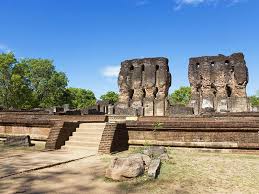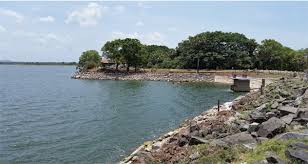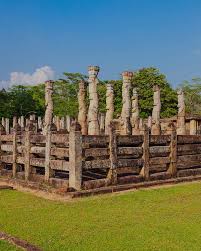Polonnaruwa, a UNESCO World Heritage Site, is one of Sri Lanka’s most significant ancient cities, located in the country’s north-central region. Serving as the capital of the island from the 11th to 13th centuries, it boasts well-preserved ruins that reflect the grandeur of medieval Sri Lankan civilization. The city is renowned for its impressive Buddhist monuments, including the Gal Vihara rock temple, which houses exquisite carvings of Buddha. Key attractions include the Royal Palace, the Council Chamber, the Parakrama Samudra (a vast reservoir), and the ancient Shiva temples.
Polonnaruwa is also known for its advanced irrigation systems, which supported agriculture and contributed to the region’s prosperity. The site’s archaeological richness offers visitors a window into Sri Lanka’s cultural, religious, and architectural heritage. With its peaceful atmosphere, ancient ruins, and surrounding natural beauty, Polonnaruwa is a captivating destination for history enthusiasts and travelers alike.
Explore the Gal Vihara

The Gal Vihara, located in Polonnaruwa, is one of Sri Lanka’s most significant and awe-inspiring ancient Buddhist sites. This rock temple, dating back to the 12th century, is renowned for its stunning collection of sculptures carved directly into a massive granite rock face. The site was commissioned by King Parakramabahu I and is a testament to the skill of ancient Sinhalese craftsmen.
The most famous feature of Gal Vihara is the reclining Buddha, an immense statue measuring over 14 meters in length, depicting the Buddha in his final moments before reaching Nirvana. Other notable sculptures include a standing Buddha, a seated Buddha, and a meditative Buddha, each showcasing exquisite artistry and attention to detail.
The serene and peaceful atmosphere of the site, surrounded by the remnants of ancient structures, makes Gal Vihara a must-visit for history enthusiasts and those seeking to connect with Sri Lanka’s rich Buddhist heritage.
The Royal Palace Complex in Polonnaruwa is a historical site that offers a glimpse into the grandeur of Sri Lanka’s medieval kingdom. Dating back to the 11th and 12th centuries, the complex was once the residence of the kings who ruled the island. It was built by King Parakramabahu I, who transformed Polonnaruwa into a thriving capital.
The palace is an architectural marvel, with its remains spread across the area, including the king’s audience hall, palace chambers, and bathing pools. A standout feature is the King’s Council Chamber, a large stone structure with intricately carved columns and a throne that once held royal court meetings. Another notable part of the complex is the Lotus Pond, a beautifully designed pool where the king could relax and take in the surroundings.
Exploring the Royal Palace Complex provides a sense of the grandeur of the Polonnaruwa Kingdom and its historical significance in Sri Lanka’s past. It’s a must-visit site for those interested in ancient architecture and royal history.
Visit the Royal Palace Complex

Walk Around Parakrama Samudra

Parakrama Samudra is a vast and impressive ancient reservoir located in Polonnaruwa, Sri Lanka, built during the reign of King Parakramabahu I in the 12th century. The name “Parakrama Samudra” translates to “Sea of Parakrama,” a fitting description for this massive irrigation system, which spans over 2,500 acres. It was designed to provide water for farming and ensure the prosperity of the kingdom.
Walking around the reservoir offers a peaceful and scenic experience. The water’s edge is lined with lush greenery, and the surrounding landscape is dotted with ancient structures, such as sluice gates, stone inscriptions, and bathing pools. The reservoir is an engineering marvel, showcasing the ingenuity of ancient Sri Lankan civilization in managing water resources for agriculture.
The area around Parakrama Samudra is perfect for leisurely walks, birdwatching, and photography, with stunning views of the water and nearby ruins. It’s a serene spot for those interested in both nature and history.
Polonnaruwa has several ancient Hindu temples dedicated to Lord Shiva. The Kiri Vehera and Shiva Devalaya No. 2 are notable examples, with intricate carvings and historical significance.
Visit the Shiva Devalayas (Temples)

Explore the Royal Baths (Nissanka Latha Mandapaya)

The Royal Baths, also known as the Nissanka Latha Mandapaya, are an intriguing and historically significant site in Polonnaruwa, dating back to the 12th century. These beautifully preserved structures were built during the reign of King Nissanka Malla, who ruled from 1187 to 1196. The Royal Baths were part of the king’s palace complex and were used for royal bathing ceremonies, serving both as a symbol of luxury and a functional area for the royal court.
The Nissanka Latha Mandapaya consists of a series of intricately designed stone pavilions and pools, with water flowing through channels carved into the stone. The most notable feature is the stone lotus-shaped pool, which is believed to have been used for bathing. The walls surrounding the pools are adorned with fine carvings, showcasing the sophistication of ancient Sinhalese architecture.
A visit to the Royal Baths offers insight into the opulence of the medieval Sinhalese kings and their remarkable engineering feats. It’s a must-see for history enthusiasts exploring the ancient city of Polonnaruwa.
A bicycle tour around the ancient city of Polonnaruwa offers a unique and immersive way to explore this UNESCO World Heritage site. Cycling through the historic ruins allows you to experience the grandeur of the ancient kingdom at your own pace while enjoying the serene landscapes surrounding the archaeological park.
The tour typically takes you through the Royal Palace Complex, the impressive Gal Vihara with its rock-carved Buddha statues, and the majestic Parakrama Samudra reservoir. You’ll also pass by important temples like the Shiva Devalayas and Vatadage, with their intricate stonework and ancient relics.
Biking provides a perfect combination of adventure and relaxation, allowing you to pause at each key site for a closer look or a photograph. The cool breeze and open paths make it an enjoyable way to discover the historical significance of Polonnaruwa. This bicycle tour is a great way to explore the ancient capital’s rich history, vibrant culture, and architectural wonders.
Bicycle Tour Around the Ancient City

See the Statue of King Parakramabahu I

The Statue of King Parakramabahu I stands as a monumental tribute to one of Sri Lanka’s greatest medieval kings, located near the Royal Palace Complex in Polonnaruwa. King Parakramabahu I, who ruled from 1153 to 1186, is celebrated for his remarkable achievements in unifying Sri Lanka, promoting irrigation, and overseeing the construction of extensive water management systems, such as the Parakrama Samudra reservoir.
The statue, crafted from stone, is an impressive figure of the king seated on a throne, symbolizing his authority and leadership. The statue’s dignified posture and facial expression reflect the king’s wisdom and power. It stands as a symbol of his contributions to the island’s prosperity and the architectural grandeur of the era.
Visiting this statue offers insight into the legacy of Parakramabahu I and the role he played in elevating Polonnaruwa as a flourishing capital. The statue remains an important historical marker and a must-see for those exploring the ancient city.
The Archaeological Museum of Polonnaruwa is an excellent place to deepen your understanding of the ancient city’s rich history. Located near the entrance to the archaeological park, the museum showcases an extensive collection of artifacts from the medieval period, offering insight into the culture, architecture, and daily life of the people who once inhabited this vibrant kingdom.
The museum’s exhibits include stone carvings, ancient sculptures, inscriptions, and ceramic artifacts that date back to the 11th to 13th centuries, during the height of Polonnaruwa’s prominence as Sri Lanka’s capital. Notable displays include a replica of the Sacred Tooth Relic casket, Buddha statues, and objects that provide context to the grandeur of the Polonnaruwa era, such as tools and coins used during that time.
The museum also offers detailed information on the city’s irrigation systems, religious structures, and the legacy of rulers like King Parakramabahu I. It’s a perfect starting point for anyone interested in the history and heritage of this UNESCO World Heritage site.
Visit the Archaeological Museum

Tour the Vatadage (Circular Temple)

The Vatadage, or Circular Temple, is one of the most iconic and well-preserved structures in Polonnaruwa, showcasing the architectural brilliance of Sri Lanka’s ancient kings. Believed to have been built during the reign of King Parakramabahu I in the 12th century, the Vatadage is a circular, stone-encased temple that once housed sacred relics.
The temple’s unique design features a circular stone platform surrounded by intricately carved stone pillars and steps. At the center, there is a raised platform, likely where a statue or relic of the Buddha was placed. The structure is renowned for its graceful symmetry and ornamental details, including beautiful stone carvings and decorative balustrades.
The Vatadage is also a significant religious site, symbolizing the harmony between nature, religion, and architecture. Visitors can explore its impressive ruins, walk among the well-preserved stone pillars, and appreciate the skill involved in its construction. Touring the Vatadage provides a deeper understanding of the grandeur and spiritual significance of Polonnaruwa’s ancient civilization.
The Ancient Alahana Pirivena Monastic Complex in Polonnaruwa is an intriguing and historically significant site that offers a glimpse into the religious and monastic life of ancient Sri Lanka. Built during the reign of King Parakramabahu I in the 12th century, this large monastic complex once served as a center for Buddhist learning and meditation.
The complex is home to a variety of architectural features, including Buddhist shrines, meditation halls, and residential quarters for monks. One of the key attractions is the large stone-pillared structure, which was likely used for assembly or teachings. The site also includes several smaller shrines, stupas, and pools used for ritual purification.
Walking through the Alahana Pirivena offers a peaceful experience, with the ruins reflecting the grandeur of Polonnaruwa’s Buddhist heritage. It’s a serene spot to appreciate the architectural and spiritual legacy of the ancient kingdom while exploring its vibrant monastic culture.
Visit the Ancient Alahana Pirivena Monastic Complex
